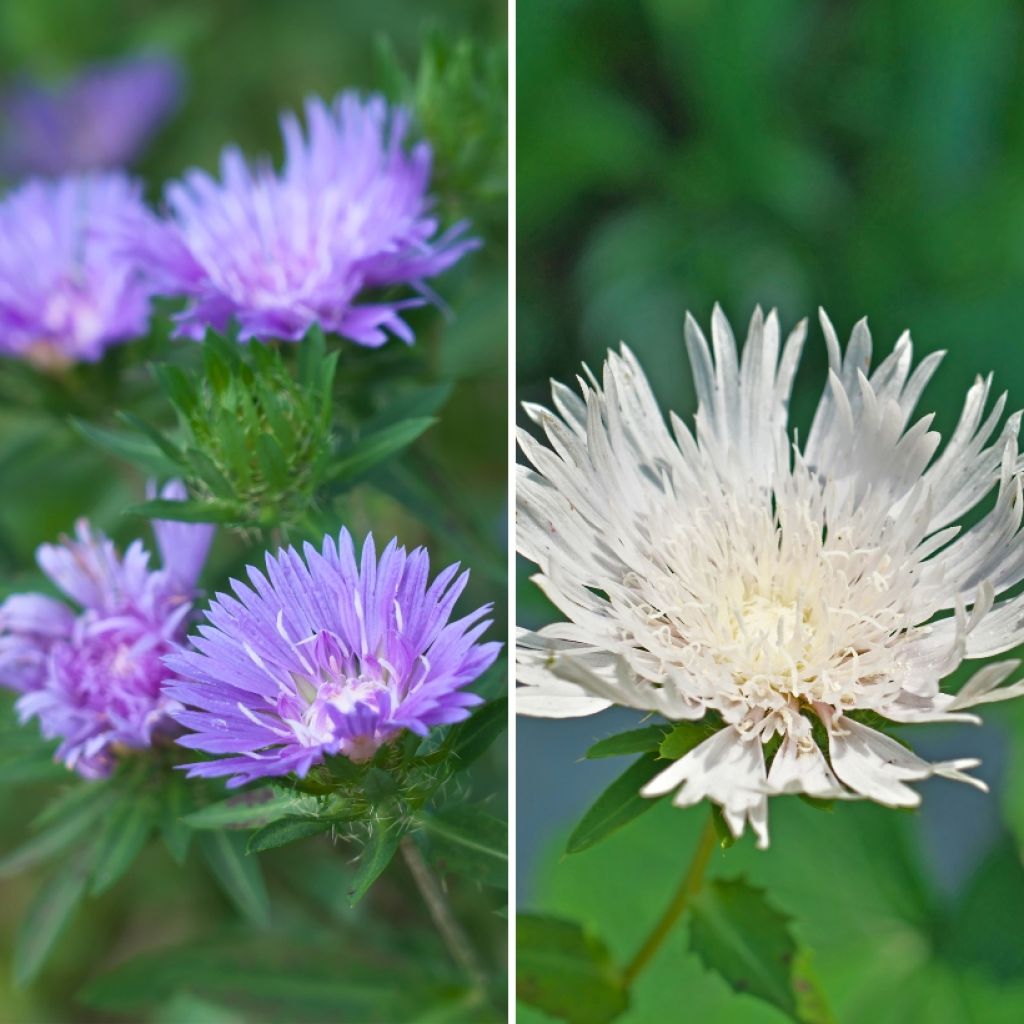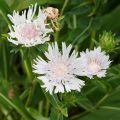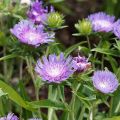Plantfit
Log in / Register
Existing customer?
New customer?
Create an account to track your orders, access our customer service and, if you wish, make the most of our upcoming offers.
My Account
Hello
Shipping country and language
Your country of residence may be:
For a better user experience on our website, you can select:
Your shipping country:
Andorra
Austria
Belgium
Bulgaria
Croatia
Czechia
Denmark
Estonia
Finland
France
Germany
Greece
Hungary
Iceland
Ireland
Italy
Latvia
Lithuania
Luxembourg
Monaco
Netherlands
Poland
Portugal
Romania
Slovakia
Slovenia
Spain
Sweden
Switzerland
Language:
French
English


Stokesia laevis Alba and Blue Star
Stokesia laevis Alba and Blue Star
Stokesia laevis Alba, Blue Star
Stokes' Aster
Order in the next for dispatch today!
Dispatch by letter from €3.90.
Delivery charge from €5.90 Oversize package delivery charge from €6.90.
More information
This item is not available in your country.
Select delivery date,
and select date in basket
This plant carries a 12 months recovery warranty
More information
We guarantee the quality of our plants for a full growing cycle, and will replace at our expense any plant that fails to recover under normal climatic and planting conditions.
From €5.90 for pickup delivery and €6.90 for home delivery
Express home delivery from €8.90.
Does this plant fit my garden?
Set up your Plantfit profile →
Collection items (2 plants)
Description
This pair of Stokesias is composed of Stokesia laevis 'Alba' and Stokesia laevis 'Blue Star', two perennial plants ideal for adding colour to the garden for long weeks while promoting biodiversity. American Cornflowers can flower from July to October and bring a very natural charm to any setting. They can withstand temperatures as low as -15°C and tolerate drought as well as slightly acidic or limestone soils.
The duo consists of:
1 x Stokesia laevis 'Alba': This variety is distinguished by its white pompon-shaped flowers, a characteristic that sets it apart from its blue-flowering cousin. It generally reaches a height of about 40 cm when in bloom.
1 x Stokesia laevis 'Blue Star': Its sky blue flowers with white centres are very bright. Slightly taller than the previous variety, it measures 50 to 60 cm high.
These Stokesias should be planted in spring or autumn, in perfectly drained, non-limestone soil, and in full sun. They will look beautiful in flowerbeds, borders, or rockeries, but can also be planted in pots to enhance a terrace or balcony. For optimal visual effect, place the taller 'Blue Star' variety behind the slightly shorter 'Alba' form. Allow for 5 to 6 plants per square metre, with a spacing of 40 cm between each plant.
The Stokesias in this duo can be paired with Gaura lindheimeri 'Blanche' to create an interesting contrast with their delicate white flowers. Also add an Echinacea purpurea 'Magnus', with its pink flowers, to enrich the colour palette. A variety of Penstemon digitalis, such as 'Husker Red', with its white flowers and dark foliage, will perfectly complement this scene. These companion plants arranged in a mix with the Stokesias make a rich and diverse composition.
Flowering
Foliage
Plant habit
Botanical data
Stokesia
laevis
Alba, Blue Star
Asteraceae
Stokes' Aster
Cultivar or hybrid
Planting and care
The Stokesia laevis is easy to grow in any non-limestone soil, perfectly drained and in full sun. However, this plant tolerates partial shade in very sunny climates. A soil that retains moisture in winter is the main cause of failure in growing the American bluebell. It is essential to add good draining materials such as coarse sand, gravel or small stones to a clayey planting soil, to a depth of 30-40 cm. Even though it appreciates moist soils, it surprisingly tolerates drought very well. In colder regions, it is useful to apply mulch to the crown in winter to make it more beautiful in spring. Remove faded flowers and regularly remove dried stems to encourage re-flowering. This plant is not susceptible to diseases or pests.
Planting period
Intended location
Care
This item has not been reviewed yet - be the first to leave a review about it.
Haven't found what you were looking for?
Hardiness is the lowest winter temperature a plant can endure without suffering serious damage or even dying. However, hardiness is affected by location (a sheltered area, such as a patio), protection (winter cover) and soil type (hardiness is improved by well-drained soil).

Photo Sharing Terms & Conditions
In order to encourage gardeners to interact and share their experiences, Promesse de fleurs offers various media enabling content to be uploaded onto its Site - in particular via the ‘Photo sharing’ module.
The User agrees to refrain from:
- Posting any content that is illegal, prejudicial, insulting, racist, inciteful to hatred, revisionist, contrary to public decency, that infringes on privacy or on the privacy rights of third parties, in particular the publicity rights of persons and goods, intellectual property rights, or the right to privacy.
- Submitting content on behalf of a third party;
- Impersonate the identity of a third party and/or publish any personal information about a third party;
In general, the User undertakes to refrain from any unethical behaviour.
All Content (in particular text, comments, files, images, photos, videos, creative works, etc.), which may be subject to property or intellectual property rights, image or other private rights, shall remain the property of the User, subject to the limited rights granted by the terms of the licence granted by Promesse de fleurs as stated below. Users are at liberty to publish or not to publish such Content on the Site, notably via the ‘Photo Sharing’ facility, and accept that this Content shall be made public and freely accessible, notably on the Internet.
Users further acknowledge, undertake to have ,and guarantee that they hold all necessary rights and permissions to publish such material on the Site, in particular with regard to the legislation in force pertaining to any privacy, property, intellectual property, image, or contractual rights, or rights of any other nature. By publishing such Content on the Site, Users acknowledge accepting full liability as publishers of the Content within the meaning of the law, and grant Promesse de fleurs, free of charge, an inclusive, worldwide licence for the said Content for the entire duration of its publication, including all reproduction, representation, up/downloading, displaying, performing, transmission, and storage rights.
Users also grant permission for their name to be linked to the Content and accept that this link may not always be made available.
By engaging in posting material, Users consent to their Content becoming automatically accessible on the Internet, in particular on other sites and/or blogs and/or web pages of the Promesse de fleurs site, including in particular social pages and the Promesse de fleurs catalogue.
Users may secure the removal of entrusted content free of charge by issuing a simple request via our contact form.
The flowering period indicated on our website applies to countries and regions located in USDA zone 8 (France, the United Kingdom, Ireland, the Netherlands, etc.)
It will vary according to where you live:
- In zones 9 to 10 (Italy, Spain, Greece, etc.), flowering will occur about 2 to 4 weeks earlier.
- In zones 6 to 7 (Germany, Poland, Slovenia, and lower mountainous regions), flowering will be delayed by 2 to 3 weeks.
- In zone 5 (Central Europe, Scandinavia), blooming will be delayed by 3 to 5 weeks.
In temperate climates, pruning of spring-flowering shrubs (forsythia, spireas, etc.) should be done just after flowering.
Pruning of summer-flowering shrubs (Indian Lilac, Perovskia, etc.) can be done in winter or spring.
In cold regions as well as with frost-sensitive plants, avoid pruning too early when severe frosts may still occur.
The planting period indicated on our website applies to countries and regions located in USDA zone 8 (France, United Kingdom, Ireland, Netherlands).
It will vary according to where you live:
- In Mediterranean zones (Marseille, Madrid, Milan, etc.), autumn and winter are the best planting periods.
- In continental zones (Strasbourg, Munich, Vienna, etc.), delay planting by 2 to 3 weeks in spring and bring it forward by 2 to 4 weeks in autumn.
- In mountainous regions (the Alps, Pyrenees, Carpathians, etc.), it is best to plant in late spring (May-June) or late summer (August-September).
The harvesting period indicated on our website applies to countries and regions in USDA zone 8 (France, England, Ireland, the Netherlands).
In colder areas (Scandinavia, Poland, Austria...) fruit and vegetable harvests are likely to be delayed by 3-4 weeks.
In warmer areas (Italy, Spain, Greece, etc.), harvesting will probably take place earlier, depending on weather conditions.
The sowing periods indicated on our website apply to countries and regions within USDA Zone 8 (France, UK, Ireland, Netherlands).
In colder areas (Scandinavia, Poland, Austria...), delay any outdoor sowing by 3-4 weeks, or sow under glass.
In warmer climes (Italy, Spain, Greece, etc.), bring outdoor sowing forward by a few weeks.

